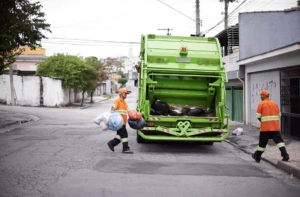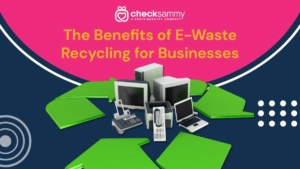The 12 Sustainability Trends Influencing the Industry
Sustainability has taken center stage in the business world as businesses recognize the importance of integrating ESG factors into their corporate strategies. As we navigate through the challenges and opportunities presented by current environmental challenges, it has become ever more important to keep pace with the emerging sustainability trends shaping the business landscape. Let’s explore twelve of the top sustainability trends for business, from the circular economy and carbon footprint reduction to smart waste management.
1. Circular Economy
Businesses are increasingly moving towards a circular economy model, a closed-loop system where waste is minimized and resources are continually reused and recycled, minimizing the strain on natural resources and the environment. Business efforts include reducing waste, designing more durable products, increasing recycling and repurposing materials, and creating new products from waste materials.
2. Carbon Footprint Reduction
With increased pressure to minimize environmental impact, companies are working hard to reduce greenhouse gas (GHG) emissions generated by their operations, products, and supply chains. Beyond exploring innovative, costly low-carbon technologies and products, many organizations are participating in carbon offset programs, from reforestation to supporting clean energy projects. By purchasing carbon offset credits from places like CheckSammy’s Carbon Offset Marketplace, businesses can demonstrate their commitment to sustainability, comply with regulatory requirements, and potentially improve their ESG score.
3. Zero Waste Initiatives
Governments and businesses are increasingly adopting zero waste goals, which aim to minimize waste generation and divert materials from landfills and incinerators by emphasizing resource recovery, recycling, and reuse. Related to the concept of the circular economy, zero waste initiatives aim to create closed-loop systems that mirror nature by continually repurposing materials to the point where nothing is discarded. These initiatives help reduce the pollution, resource extraction, and greenhouse gas emissions associated with waste disposal. One notable example of a company’s zero waste initiative is the efforts made by Unilever, a multinational consumer goods company. In 2016, Unilever announced that it had achieved zero waste to landfill across 600 Unilever sites through efforts that included redesigning packaging, implementing waste segregation and recycling systems, finding ways to use waste as a resource, and more.
4. Waste-to-Energy Technologies
It’s easier than ever to convert waste into useful energy sources with advances in the associated technology that converts waste into energy, from anaerobic digestion to gasification. By converting waste materials into usable forms of energy, including heat, electricity, or fuel, companies tap into sustainable alternatives to traditional energy sources. This innovative technology provides a reliable source of energy to help businesses reduce their reliance on fossil fuels and lower energy costs.
The “Green Steam” project by Danish pharmaceutical company Novo Nordisk is one example of a successful WtE initiative, through building a large-scale biogas plant to convert wastewater and other organic waste from its insulin production facility into biogas that can then generate heat and electricity for the facility.
5. Plastic Waste Reduction
With the growing awareness of plastic pollution, there is an increasing focus on reducing single-use plastics and improving plastic recycling processes. These efforts include phasing out single-use plastics like straws, utensils and bags, redesigning product packaging, using recycled plastic, encouraging reuse and refill retail options, and more. In a move towards reducing plastic, for example, Coca-Cola committed to making 100% of its packaging recyclable by 2025.
6. Extended Producer Responsibility (EPR)
EPR policies require manufacturers to take responsibility for the end-of-life management of their products, leading to better waste management and recycling practices. These policies promote a shift towards a circular economy by incentivizing businesses to design more sustainable products and packaging and to support the development of infrastructure for waste collection, recycling, and disposal. Electronics trade-in programs where manufacturers accept end-of-life products and recycle them – like Apple Trade In – are an example of how large corporations are working to follow the standards set forth by EPR policies.
7. Smart Waste Management
The use of Internet of Things (IoT) devices, sensors, data analytics, and automation is helping optimize waste collection, sorting, and recycling processes, making waste management and recycling more efficient and cost-effective. Using smart technology like CheckSammy’s smart recycling bins, businesses can monitor and manage waste generation more efficiently, which helps drive cost savings and improved operational performance. For example, Swedish furniture retailer IKEA uses sensors and compactors to monitor waste generation and optimize waste collection across its stores and warehouses.
8. Biodegradable and Compostable Materials
More companies are using biodegradable and compostable materials to replace items that are not environmentally friendly, like packaging, disposable cutlery, and single-use products. Many businesses are replacing plastic bags with biodegradable alternatives made out of starch or cellulose. Instead of styrofoam or plastic food containers, they’re using compostable options made from plant-based materials like bagasse or PLA (polylactic acid). Other companies are developing innovative biodegradable materials like bioplastics made out of algae or waste byproducts. The options for biodegradable and compostable products are greater today than ever, making the switch much easier even for large organizations.
9. Advanced Recycling Technologies
New recycling technologies, including chemical recycling, pyrolysis, and gasification, are being developed to process hard-to-recycle materials and create high-quality recycled materials. These advanced technologies can break down complex materials into their basic components, which can then be repurposed to create new products or for use as feedstock for various industries. Businesses that adopt this tech can improve their resource efficiency, reduce waste disposal costs, and ensure regulatory compliance.
10. Community Involvement
Involving the community demonstrates corporate social responsibility, fosters goodwill, and contributes to the overall well-being of the communities where companies operate. Business leaders have come to realize that companies’ long-term success is intertwined with the health and prosperity of the communities they serve, which means that engaging in community-focused initiatives can lead to tangible benefits including improved brand reputation, customer loyalty, and employee satisfaction. From reforestation projects to beach clean-ups and community gardens, these initiatives help promote environmental stewardship and foster a sense of community.
11. Education and Awareness Campaigns
Efforts to increase public awareness and participation in recycling and waste reduction are key to achieving sustainable waste management goals. By raising awareness and promoting sustainable behaviors, businesses can drive positive change, encourage responsible consumption, and foster a culture of sustainability. One example of this trend is Patagonia’s “Don’t Buy This Jacket” campaign where the outdoor clothing retailer encouraged consumers to think critically about their purchasing decisions and the impact of consumerism on the environment. Patagonia urged customers to repair, reuse, and recycle their products, and only buy new items when necessary.
12. Policy and Regulatory Changes
Governments are implementing stricter waste management and recycling regulations, like landfill bans and recycling targets, to drive improvements in the industry. Some of the key policy and regulatory trends include carbon pricing and emissions trading, EPR regulations, renewable energy targets, and plastic reduction policies – to mention a few.
Adopt More Sustainability Trends with CheckSammy
Companies are increasingly recognizing the need to embrace sustainable practices to ensure long-term success, meet regulatory requirements, and cater to evolving consumer preferences. The move to sustainability doesn’t need to be overwhelming, especially when you have the right partner by your side. CheckSammy has worked with organizations large and small to help them implement new sustainability initiatives, and we can help you, too. Contact us today to learn more.
See Our Services
Create a custom solution to meet your waste and sustainability goals. Contact us today!
Continue reading
Dive deeper into the CheckSammy Blog by reading one of our posts below
Feeling the Pain of Higher Resident Turnover? Apartment Junk Removal Can Help
If you’re a property manager, you’ve probably had a significant increase in tenant turnover over the last couple of years. So it’s no wonder apartment junk removal may be top of mind for you right now. There are several reasons for this shift. For one, the housing market is on fire right now. In 2020 […]
Read MoreSetting Up a Community E-waste Recycling Program
E-waste is the fastest-growing municipal waste stream according to the EPA, yet e-waste recycling isn’t keeping pace. In fact, only 12.5% of all e-waste is recycled, reports the EPA. Starting a community e-waste recycling program is a terrific way to ensure hazardous e-waste, like lithium-ion batteries, doesn’t end up in your community’s landfill. Creating an […]
Read MoreWaste Management’s Role in the Circular Economy
Establishing a waste management program for your business or community is one of the best ways you can contribute to the circular economy. Here’s everything you need to know about waste management’s role in the circular economy (and how to get involved). What Is the Circular Economy? Our current economic model is all about taking […]
Read More5 Reasons to Consider a Textile Recycling Program for Your Organization
Americans sent more than 17 million tons of textiles to landfills in 2018, a volume that is only increasing every year, reports the Environmental Protection Agency. When you think about the fact that it can take over 200 years for textiles to decompose, it’s easy to grasp how large textile waste’s contribution is to the […]
Read More8 Benefits of Environmentally Friendly Power Washing Services
If you’re into maintaining the curb appeal of your business or home, then you’ve probably heard of pressure washing. Pressure cleaning involves using high-pressure water spray to remove grime, mold, dust, paint, mud, and other junk from objects or surfaces. Many people worry that pressure washing isn’t good for the environment, but this couldn’t be […]
Read MoreWhy Our Customers Love Our Full-Service Junk Removal
If you’re looking for full-service junk removal services, you’ve come to the right place. CheckSammy is a one-stop shop for all your junk removal and sustainability needs. From our affordability, simplicity, and unrivaled turnaround times to our innovative sustainability solutions and patented technology and data, it’s clear why some of North America’s biggest companies choose […]
Read MoreTips for a Stress-Free Move From An Eco-Friendly Junk Removal Company
What does an eco-friendly junk removal company know about moving? Quite a lot, actually. Moving can be an especially chaotic time. You have to pack everything up, get rid of unwanted items, clean your property, load everything up, and move your things to your new location. That doesn’t even include the unpacking and resettling period. […]
Read MoreCollege Junk Removal Tips for Student Move-In Day
As the new school year gears up, colleges across the country are looking for ways to clean up their campuses before the new year begins, and many of them want to do so sustainably. College junk removal isn’t easy, though, especially around move-in week—and when trying to do so sustainably. As students move in and […]
Read More8 Items Hospitality Businesses May Not Know They Can Recycle
One hotel guest produces 2.5 pounds of trash every single day. Just a single hotel room produces around one cubic yard of waste each month, which totals 200 gallons of waste per room every month. Most of this waste goes straight to the landfill, even though research shows that up to 60% of it is […]
Read More












